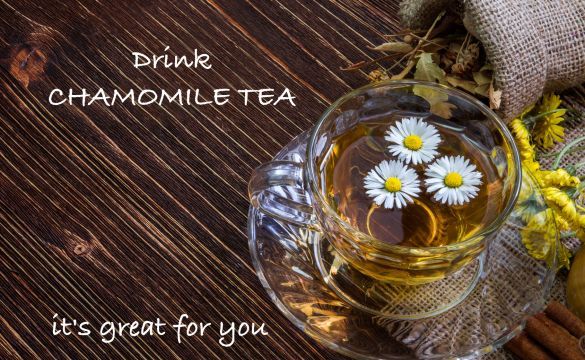
I love, love, love tea. I love any kind of hot tea really… there is something mysterious, even seductive about tea that draws me in.
I love tasting new and exciting tea blends that awaken my senses and take me on journeys to exotic lands. For me, there is nothing more relaxing than a cup of tea while reading a book or watching the sunset.
Tea is highly therapeutic. In fact, historical documentation shows us that tea is an ancient elixir that was first consumed thousands of years ago. Teas can be black, green, white or oolong. All of these are made from the leaves of the Camellia sinensis plant. Herbal teas, such as peppermint and chamomile, are not really pure teas but rather infusions of plants with different nutritional characteristics.
Health benefits of tea
The health benefits of tea are due to its high content of flavonoids. These are plant-derived compounds that are antioxidants. Out of the four tea types, green tea is the best food source, having a group of antioxidants known as catechins. According to Harvard Health Publications, catechins have shown to be more powerful than vitamins C and E in stopping oxidative damage to cells and appear to have other strong immune boosting and disease-fighting characteristics.
Studies associate green tea with the following health benefits:
- Improved weight loss
- Lowered blood pressure
- Reduced risk of cancer
- Protection from diminished cognitive function
- Reduced mortality from all causes
- Prevention of type 2 diabetes
- Reduced risk of bone fractures
- Prevention of liver disease
- Prevention of atherosclerosis
Besides powerful antioxidants, green tea increases the number of “regulatory T cells” in the body, which, according to the Linus Pauling Institute at Oregon State University, are important for optimal immune system function.
Chamomile
Chamomile is one of my most favorite teas to enjoy in the evening before bed and is best known for its soothing, sedative qualities.
The term chamomile refers to the daisy-like plants that are members of the Asteraceae family. The most common types being German chamomile (Matricaria recutita) and Roman chamomile (Chamaemelum nobile). This plant has been used medicinally since ancient times, mostly for its anti-inflammatory and calming properties.
It was also used throughout the Middle Ages for conditions such as asthma, colic, nausea, nervous complaints and skin diseases. Traditional healers have long recommended a cup of warm chamomile tea to ease anxiety and promote relaxation.
Chamomile is native to European countries and is cultivated in Egypt, Germany, France, Spain, Italy and Morocco. German chamomile is sweeter than Roman chamomile and is generally the type that is used for tea and tea blends.
Therapeutic properties
The daisy-like flowers contain volatile oils such as bisabolol, bisabolol oxides A and B, and matricin, in addition to flavonoids and other therapeutic substances.
9 great reasons to use chamomile
There are many other ways to use chamomile in addition to a warm cup of this herbal delight. Here are just nine:
Soothes digestive distress—If your stomach is upset, nothing will calm it down quicker than a cup of chamomile tea. Studies indicate that it is also useful for infant colic, nausea and ulcers.
Lowers blood sugar—A study in the Journal of Agricultural and Food Chemistry reported that there is a clear link between daily consumption of chamomile tea and prevention of the progression of diabetes and high blood sugar.
Reduces hemorrhoids—Studies indicate that a cream made from chamomile is very effective in reducing the pain, swelling and inflammation associated with hemorrhoids.
Heals wounds—Research supports the use of topical chamomile to speed wound healing. With potent antimicrobial properties, chamomile has been reported to heal wounds more rapidly than corticosteroids.
Fights cold—Although a cold is the most common human disease and a mild viral condition, it can lead to severe and even fatal conditions such as pneumonia. Studies have indicated that inhaling chamomile-infused steam can help reduce the symptoms of a common cold.
Combats insomnia—Perhaps best known for its ability to promote sleep, chamomile is widely recognized as a mild sedative and sleep-inducer. According to researchers, the sedative effect may be due to the flavonoid apigenin, that binds to benzodiazepine receptors in the brain.
Prevents gum disease—If your gums are swollen red and bleed when you brush, you may have gum disease. To reduce the inflammation, make an infusion made from three teaspoons of dried flower and a cup of hot water. Rinse with the solution up to three times a day. You can also place a warm chamomile tea bag on the inflamed area. The tannic acid in the tea helps bring down the inflammation and stop bleeding.
 Treats eczema—In terms of skin health, it can be applied topically and consumed. When applied topically, chamomile can reduce the inflammation associated with conditions like acne or eczema.
Treats eczema—In terms of skin health, it can be applied topically and consumed. When applied topically, chamomile can reduce the inflammation associated with conditions like acne or eczema.
Reduces menstrual cramps—Chamomile tea has been known as a wonderful home remedy for menstrual cramps. Drinking chamomile tea increases levels of the amino acid glycine in the body. Glycine helps to reduce cramps by reducing muscle spasms and helping the uterus to relax.
How to prepare the perfect cup
Believe it or not, there is a method to making the perfect cup of tea. Although the strength of your tea is a personal preference — the longer you let your tea steep, the stronger it will be — there are other things to consider.
Choosing safe tea: When you purchase your tea, make sure it has not been treated with epichlorohydrin. The National Institute for Occupational Safety states that epichlorohydrin is found in pesticides, coffee filters, paper tea bags and the casing of sausage. The main problem with this toxin is what happens when it comes in contact with water. Its composition is altered and a new form called 3-MCPD is created, which is highly dangerous. Also, avoid tea bags that are “mesh like” or in fancy shapes since these are also likely to contain chemicals.
Organic: Always buy organic tea or you risk consuming tea that has been sprayed with pesticides. Don’t give up on your tea, just practice, as always, caveat emptor when making choices for you and your family. As with any food, the less humans have tampered with it, the better.
Water: Always use fresh and filtered water to make your tea — never treated tap water. The better your water tastes, the better your tea will taste.
Steeping time: A team at the University of Northumbria’s School of Life Science found that the best tasting tea resulted from two minutes of steeping followed by four minutes of setting. This allows the water to cool from boiling to an optimal temperature that encourages the strongest release of flavors. If the tea is left to cool too long, the flavors seem to be destroyed.
Maximum antioxidant benefit: While you can pour water over your tea bag and let it set, you can get five times the antioxidant power from your tea by simply bobbing the bag up and down a few times in the water.
Although this takes a little more effort, it is well worth it, especially if you want to get all of the health promoting benefits from your tea. If your tea bag does not have a string, use a spoon to dip and remove the bag.
Have you enjoyed your cup of chamomile today?
-Susan Patterson
Susan is the Content Director at The Alternative Daily, a Certified Health Coach, Certified Metabolic Typing Advisor and Master Gardener. With an extensive knowledge of whole foods and wellness, Susan enjoys educating others on how to live healthy and sustainable lives. She presently lives off grid in the middle of the New Mexican high desert with her three children and numerous animals.
Sources:
http://www.ncbi.nlm.nih.gov/pmc/articles/PMC2995283

